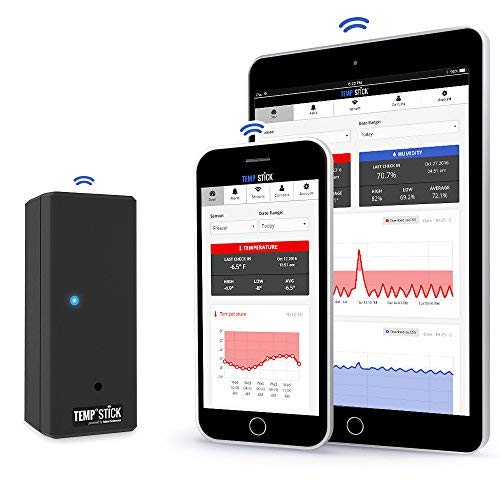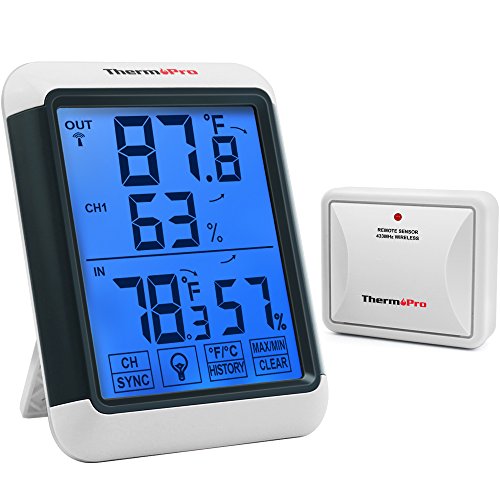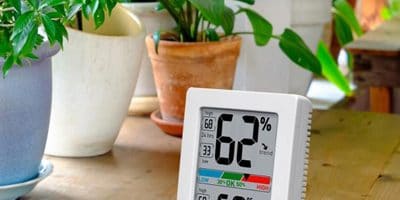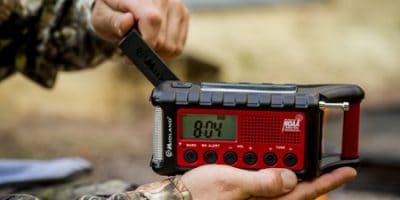
Using a greenhouse thermometer and hygrometer will allow you to monitor and control two critical variables in plant development—temperature and humidity. Gardeners build greenhouses to have greater control over their plants’ environment, which leads to better results at harvesting time. It also allows us to extend the growing season, especially in regions where there are extreme temperatures—either hot or cold.
However, if it’s too hot, your plants may wither, and if it’s too cold, your plants may not grow well, if at all. Balancing humidity by regulating the moisture in the air is also key to ensuring optimal growth and yield.
Want to learn more about the optimal conditions for your greenhouse? Watch this video below:
To help monitor and maintain the ideal growing conditions for your plants, flowers, or vegetables inside your greenhouse, you will need a reliable and accurate thermometer.
In this guide, we have listed the top models on the market to help you find the best greenhouse thermometer and hygrometer for your needs.
Our team of editors independently research, test, and recommend the best products to help you navigate when shopping online. This post contains compensated links, and if you make a purchase using the links included, we may earn a commission. To learn more, read our disclaimer.
Wireless Remote Greenhouse Temperature Monitors
Remote greenhouse temperature monitors are our top recommendation to monitor temperature and humidity. As the name suggests, you don’t need to be in the greenhouse to read the conditions. You can see the temperature and humidity from anywhere on your smartphone or PC. Best of all, with a remote greenhouse temperature monitor, you can set alarms to instantly notify you when the temperature or humidity exceeds your ideal parameters. You can also store and view historical data, allowing you to spot trends and identify any issues.
These remote greenhouse thermometers work through either a WiFi network or Bluetooth, so you can view conditions from anywhere at any time and receive alerts. Wireless greenhouse temperature monitoring systems are more expensive than a standard digital thermometer. However, they are, by far, the most convenient way to monitor your greenhouse.
Best Overall: Temp Stick WiFi Temperature and Humidity Sensor
Made in the USA by Ideal Sciences, the Temp Stick is an accurate and user-friendly WiFi greenhouse thermometer that will allow you to monitor the environment inside your greenhouse remotely. It operates with 2 AA batteries, which provide a battery life of up to 1 year. The sensor is completely wireless, no gateway devices are required, and there are no subscription fees.
The Temp Stick sensor is straightforward to set up. It takes just 3 minutes to get connected, and it comes factory calibrated. All data and settings are accessed through an intuitive app available for both iOS and Android. You can view an unlimited history of readings through the app and set your custom alerts for high and low temperatures and humidity. The Temp Stick greenhouse thermometer will also provide alerts for WiFi connection loss and low battery. The alerts can be sent by text and email to up to ten different contacts. If needed, you can also add an unlimited number of Temp Stick devices to monitor multiple levels of your greenhouse within one account.
The Temp Stick is a trustworthy sensor that will get the job done without any hassle. The greenhouse thermometer and hygrometer comes with a 3-year warranty, and if you need any help, there is email and phone support available seven days a week from a USA-based team. We have rated the Temp Stick the best temperature monitor overall in our WiFi thermometer buying guide.
Use our link below to get the Temp Stick at an unbeatable price directly from Ideal Sciences.
Click here to check the price of our #1 recommendation: the Temp Stick
Runner-Up: Ambient Weather WS-8482-X3
While the Temp Stick is by far our favorite, in some situations, the Ambient Weather WS-8482-X3 might be the better option to monitor the temperature in your greenhouse. This greenhouse thermometer setup includes a WiFi-enabled base station/console that allows you to view data without logging into an app. Also included are three separate temperature and humidity sensors which can help you monitor different zones of your greenhouse and even outside areas. Altogether, it can support seven sensors, including optional soil moisture sensors.
The WS-8482-X3 uploads its data to AmbientWeather.net, the company’s online web and app-based portal, where you can monitor conditions and set alerts for high and low parameters. The WS-8482 is also smart home compatible, so you can use it to automatically trigger heating and cooling solutions when the temperature or humidity reaches dangerous levels. It can activate smart devices through IFTTT, and it will also work with Alexa and Google Home.
Click here to check the price of the expandable Ambient Weather WS-8482-X3 on Amazon
The SensorPush wireless thermometer hygrometer is a small and compact unit that measures just 1.57 inches x 1.57 inches x 0.65 inches and weighs only 40g. The accuracy is top-notch, thanks to Swiss-made sensing components, and the device can last more than a year on a single CR2477 coin cell battery. The user-friendly app also makes it straightforward to connect sensors, set alerts, and view data history.
If budget is a concern, then the SensorPush is a worthy choice. While it offers similar monitoring capabilities as the greenhouse thermometers above, you connect to the SensorPush by Bluetooth instead of WiFi to receive data.
The Bluetooth connection has a line of sight range of 325 feet, and the sensor can store up to 20 days of data if you lose the connection. The data will then be pushed to your phone when you reconnect. However, you can also purchase the optional SensorPush G1 WiFi Gateway for Internet monitoring and alerts from anywhere. The gateway device can connect to an unlimited amount of SensorPush sensors. As the sensors are quite affordable, you can easily set up extra sensors throughout your greenhouse.
Digital Greenhouse Thermometers and Hygrometers
If you only want basic greenhouse temperature monitoring, then consider a digital min/max greenhouse thermometer. We recommend a digital greenhouse thermometer over analog as they will allow you to easily see the minimum and maximum temperatures over a 24-hour period, along with the current temperature and humidity.
You won’t get the remote monitoring and alerts through to your smartphone with these greenhouse thermometers. Still, as a result, they’re much cheaper and a great option for the casual gardener or greenhouse owner that’s growing less temperature-sensitive plants.
But don’t confuse the lower price with a lack of quality. These greenhouse thermometers still provide relatively accurate readings. In some models, you even get the option to connect multiple sensors.
The Ambient Weather WS-10 is a good option if you want the basics with the added ability to track conditions in more than one location. The package comes with an indoor thermo-hygrometer inside the console and three separate indoor/outdoor sensors. Unlike most models, the additional sensors have a readout of the current temperature and humidity.
The console allows you to track maximum and minimum temperatures and includes an audible and visual alarm triggered by your sensors exceeding preset levels. While the console can only show data from four sensors at any given time, the WS-10 supports a total of eight sensors in all. You’ll just need to scroll through the sensors on the console to see them. Lastly, you’ll need to make sure that wherever you place the display, it is in the sensors range. The sensors have a transmission range of 300 feet line of sight (100 feet under most conditions).
The ThermoPro TP65A thermometer is an affordable digital greenhouse thermometer with functionality for additional sensors. One of the best features of the TP65A is its large backlit display. The large display allows you to view the data from a distance easily, and it will show you current conditions, 24-hour high and low readings, plus all-time records.
The package includes a console with a built-in indoor thermometer/hygrometer and one remote sensor with a 200ft range. While the console uses 4 AAA batteries, the sensors themselves are rechargeable via USB, meaning there are no batteries to change. If you’d like, you can add up to two additional sensors. However, these sensors aren’t cheap—so we’d recommend the Ambient Weather WS-10 instead if you need that capability.
The AcuRite 01083 temperature and humidity monitor is our most basic recommendation and also the cheapest. While intended for indoor use (the “air comfort indicator” displays optimal humidity for indoor comfort), some users are also placing the AcuRite 01083 in their greenhouses. The display shows both temperature and humidity, along with maximum and minimum readings.
This option is best for casual gardeners who only need to track conditions at a single location. We’d strongly recommend the other greenhouse thermometers above for more serious gardeners. Still, we can’t argue with the price. AcuRite’s devices are generally quite reliable, so the AcuRite 01083 hygrometer is worthy of being mentioned here, with thousands of five-star reviews on Amazon. To see more digital hygrometer reviews, take a look at our article, where we reveal the best hygrometer.
Greenhouse Weather Stations
We’re willing to bet if you already have a greenhouse, chances are you’re pretty serious about gardening and the weather. You’re probably growing outdoors, too. Instead of purchasing just a thermometer for your greenhouse, why not consider a weather station instead? A greenhouse weather station will allow you to monitor conditions inside and outside of your greenhouse. It will also provide a forecast and offer a complete view of all the weather conditions that can impact your gardening.
Ambient Weather sells two great weather stations suitable for gardeners that you should consider, both of which connect to the Internet so you can view the weather remotely from your computer or smartphone and set custom alarms. With these weather stations, you can expand the setup to include additional sensors depending on your needs, so you’ll never outgrow your installation.
The Ambient Weather WS-2000 is the company’s top of the line weather station, featuring a wireless all-in-one outdoor sensor suite (including temperature, wind speed/direction, rainfall, humidity, UV, and solar radiation). The WS-2000’s premium HD display console allows you to easily view data from your station and additional sensors as well, including extra thermo-hygrometers, probed thermometers, lightning, soil moisture, water leak, and even air quality sensors.
The console also includes WiFi connectivity, so you can upload your data to the Ambient Weather network and third-party services like Weather Underground. You can set alerts and view the weather conditions inside and outside of your greenhouse remotely, and the station can also trigger smart home devices through IFTTT.
The WS-2000 is one of our favorite personal weather stations. It’s accurate, durable, and user-friendly while also being very affordable for a premium grade station. We have rated it as the best premium model on the market in our weather station buying guide.
A step down from the WS-2000 is the WS-2902C. The package includes the same wireless sensor suite as the WS-2000 but with a much simpler (and frankly not as stunning) console. The station supports extra thermo-hygrometers, probed thermometers, and air quality monitors. However, while you can add additional sensors to the WS-2902C, you’ll only be able to view the data through the Ambient Weather network—not on the console. That’s the biggest downside.
We had the chance to test an earlier version of the WS-2902C and found the performance and accuracy to be almost on par with much more expensive personal weather stations like those from Davis Instruments. While we recommend the WS-2000 if you can afford it, the WS-2902C is a worthy and high-performing alternative that offers excellent value for money. It’s a perfect starter model for a passionate gardener and weather enthusiast.
Greenhouse Thermometer Frequently Asked Questions
Q: Where Is the Best Place for a Thermometer in a Greenhouse?
A: To measure conditions accurately in your greenhouse, you’ll need to keep a few things in mind. The thermometer should be at plant level and out of direct sunlight. Suppose you have a mixture of hanging and ground-level plants. In that case, you’ll want to place thermometers in both areas (the temperature and humidity levels will not be the same!). It’s best to position sensors away from heat or cold sources, i.e., away from the roof, doors, or windows.
Q: What Is the Ideal Greenhouse Temperature and Humidity?
A: Each crop you grow is going to have different temperature and humidity requirements for optimal growth. This information is typically provided on the bulb or seed packaging and often easily searchable online, so start there first. Generally, you’ll want to keep the temperature between 80-85°F and the relative humidity between 50-70%.
Q: How Do You Control the Temperature and Humidity in a Greenhouse?
A: All greenhouses include vents, which can open and close to help maintain temperature. If you can afford it, opt for automatic vents, exhaust fans, and circulation fans. These solutions might not be enough to keep your greenhouse cool during the summer, so using shade cloths to filter the sunlight’s strength may be necessary. Maintaining a regular watering cycle is vital to control the humidity, although using a dehumidifier may help.
Final Thoughts
To ensure that your plants thrive inside your greenhouse, you will need to monitor the temperature and humidity with an accurate and dependable greenhouse thermometer. We recommend choosing a remote temperature monitor (or a weather station if you can afford it) so you can easily monitor conditions from your smartphone and receive alerts when conditions are outside of your ideal range. In particular, we recommend the Temp Stick WiFi Sensor and the Ambient Weather WS-2000 Smart Weather Station.












